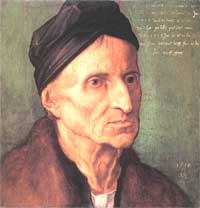Albrecht Dürer - The years from 1507 to 1520
Dürer did not leave any personal account about the years between 1507 and 1520. Judging by the high number of works executed between these years, we conclude that it was a period of intense work.

Portrait of Michael Wolgemut, 1516 Germanisches Nationalmuseum, Nuremberg
In 1507 he finished the "Adam and Eve", now in the Prado Museum in Madrid, for which the artist made studies while in Venice.
In the same year, Dürer received a commission from Jacob Heller, a rich merchant from Frankfurt, to paint an altar representing the “Assumption of the Virgin.” The picture was finished in 1509, and the letters exchanged between the patron and the painter are showing the former’s growing impatience. The artist wrote to the merchant that he will never again engage in executing such a large work, however, an even larger altarpiece, the famous "Adoration of the Trinity," now in Kunsthistorisches Museum, Vienna, was executed in 1511 for Matthaeus Landauer.
In 1508, the Elector Frederick the Wise asked Dürer to paint the " The Martyrdom of the Ten Thousand," now also in Kunsthistorisches Museum, Vienna.
In 1511 Dürer published a second edition of his Apocalypse, enlarged his series of woodcuts representing the "Life of the Virgin", and engraved on wood a series of twelve large-size pages representing scenes from the Passion and a cycle of thirty-seven small scenes with the same subject.
In 1512, for the Imperial Treasury in Nuremberg, he painted the Emperors Charlemagne and Sigismund in heroic size, now in the Germanisches Nationalmuseum, Nuremberg. He also finished the majority of the seventeen engravings on copper of scenes from the Passion.
In 1512, Emperor Maximilian became Dürer’s main patron. Following the request of the Emperor, he made the largest woodcut known, the "Triumph of Maximilian." The "Triumphal Arch," was executed in 1515, and the "Triumphal Car," was interrupted by the death of the Emperor.
In 1513 and 1514 he made three famous copper-plate engravings: "Knight, Death and Devil," "Melancholy," and "St. Jerome in his Study."
On May 17th 1514, the artist suffered the great sorrow of losing his beloved mother, after a long and painful illness. He sought refuge in his work, and 1514 was a most productive year, Dürer creating some of his finest copper-plates.
In 1516 Dürer resumed painting with the portrait of his master, Michael Wolgemut, which is in the Germanisches Nationalmuseum, Nuremberg, the pictures in tempera of the Apostles James and Philip with the silvery beards, in the Galleria degli Uffizi, Florence, and “The Madonna of the Carnation”, in the Alte Pinakothek, Munich.
From 1518 dates “The Suicide of Lucrezia”, now in the Alte Pinakothek, Munich. 1518 is also the year of Dürer’s journey to Augsburg. Together with Gaspard Nützel and Lazarus Spengler, he represented Nuremberg at the Imperial Diet. While he was there, he obtained the Emperor’s permission to draw his portrait. Executed in charcoal and chalk, the drawing is now in the Graphische Sammlung Albertina, Vienna. The artist’s note on the portrait reads: "This is Emperor Maximilian whose portrait, I, Albrecht Dürer, made in Augsburg in the Pfalz, in a little room, in the year 1518, on Monday after St. John the Baptist."
In 1519, after the death of the Emperor, and using the drawing as a model, Dürer painted the portrait of Maximilian, now in Kunsthistorisches Museum, Vienna.
Next - The Journey to The Netherlands
